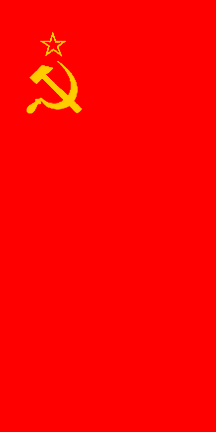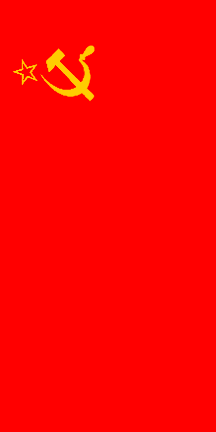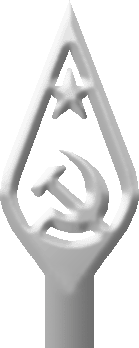António Martins, 28 Jan 2001

Last modified: 2007-09-22 by antónio martins
Keywords: soviet union | ussr | sssr | cccp | communism | hammer and sickle (yellow) | serp i molot | hammer | sickle | red flag | star: 5 points (fimbriated) | earth |
Links: FOTW homepage |
search |
disclaimer and copyright |
write us |
mirrors

The Soviet national flag, as most soviet flags, used a medium, bright
shade of red. Soviet flag laws clearly distinguish between this shade of
red, or scarlet (alyĭ | алый
![]() ),
and a darker shade (krapovyĭ |
краповый or
purpurnyĭ |
пурпурный
),
and a darker shade (krapovyĭ |
краповый or
purpurnyĭ |
пурпурный
![]() ) used only
on a few flags.
) used only
on a few flags.
António Martins, 28 Jan 2001
The hammer and sickle itself, originate from the unique Russian unity of
the peasants (the sickle) with the workers (the hammer) who together formed
the Soviet Russian state. The Red field is symbolism of the blood that has
been spilt by workers the world over in the fight for their emancipation, and
was directly inherited from the red banner flown
at the Paris Commune; the original and hitherto “base” symbol
of a worker’s government flag.
The single yellow star is both the representation of the life and immense
energy of the sun, empty because within is the blood or production of workers
struggle; and also the five points of the star symbolize the single unity and
international representation of the government — each of the five
points is representative of the five (up to then known/recognized)
continents.
Brian Basgen (Marxists Internet Archive Director), 07 Jul 2000
Soviet flag with hammer, sickle and star was not created in 1918!
It was adopted in 1923. The star on the flag was red with yellow border (not
plain red). Only the coat of arms and some military colours were with hammer
and sickle in 1918. Hammer and sickle existed in soviet symbolism since
1917.
Victor Lomantsov, 08 Jul 2000 and 09 Jul 2000
Traditionally, red has always had very positive connotations in Russian language and culture. The word "red" ("красный") is etimologically related with the words "прекрасный" ("very good", "the best") and "красивий" ("beautiful"). A Russian proverb says that «красивий — самы красный» («the more red, the better»).
Thus Moscow’s Red Square has a double meaning, referring not just to its colour but also meaning "Beautiful Square". Furthermore, the most important Russian Orthodox festivity is the so-called Red Easter, when the priests wear red vestments.
All this can help to understand why the red flag became the most popular symbol from the first moments of the 1917 revolution, being widely used even by non-Communist elements. People often ripped the white and blue stripes from the tri-colour Russian flags to make very narrow, unravelled red flags that were shown everywhere.
José Manuel Erbez, 12 Jun 2001
 image by António Martins, 08 Dec 2005 | |
No hammer, sickle and star on the
reverse side.
Mark Sensen, 25 May 1997
Officially reverse looked like obverse without star and hammer-sickle.
But in fact I never saw these flags without star, hammer-sickle. Real flags
usually were either with reverse analogous to obverse (but with star and
hammer-and-sickle near the hoist) or with reverse = mirrored obverse.
Victor Lomantsov, 30 Nov 2002

In USSR vertical flag hanging of flags
was very rare. I never saw it. But I saw a foto of 1980’ies with
vertical flag of USSR, with an upright hammer and sickle on the
upper “hoist” (dexter). I think this foto was from the
Olympic Games of 1980.
Victor Lomantsov, 20 Nov 2000
This is a special flag for vertical display.
Al Kirsch, 08 Nov 2001

If [a regular] flag was simply rotated 90 degrees clockwise, the hammer
and sickle moved to the upper right and faced “down”. If the
flag was “flipped” as the US flag
is, the hammer and sickle faced “down” and was
reversed.
Al Kirsch, 08 Nov 2001
According to my understanding, the hammer and sickle appeared only on the
obverse of the Soviet flag and the reverse was plain
red. If so, then flipping [a regular] flag over like the
US flag would give you only a vertically
hoisted plain red cloth.
Joe McMillan, 08 Nov 2001

I found a photo of a vertical
hoisted Soviet flag in the background.
Greg Shevchenko, 18 Oct 2003
It seems to be a soviet national flag flipped and rotated (following
the US practice for hanging flags), showing
the reverse and on it the hammer-and-sickle emblem, which, according to
the relevant legislation, should not be there
(only on the obverse). It would be interesting to know the location of this
event and, if possible, the provenience of the flag.
António Martins, 11 Nov 2003

This finial was used in the Soviet Union. Belarus
is currently using this finial as their own.
Zach Harden, 09 Sep 2001
.gif)
The state emblem of the Soviet Union (corresponding to a
coat of arms) had the Earth superimposed
by the hammer and sicle.
Elias Granqvist, 25 Nov 2000
Two bundles of corn ears heavily draped with a scroll, reading in all
the 15 SSR languages the motto «workers of the
world, unite thee»; the bundles encirle an earth globe (viewed approx.
from the vertical of the Black Sea) showing solid continents and coordinate
lines in 20° intervals. On it a hammer and a sickle, crossed per
saltire, in naturalistic look. Under the globe a rising sun with alternating
long and short rays made of single lines (approx. 30 visible rays); above
the globe a double fimbriated dense star.
António Martins, 05 Aug 1999
The 1956-1991 version, with the motto «Workers of all countries, unite!» in all 15 official SSR languages (here showing the original hyphenation and with transliterations for Cyrillic, Armenian and Georgian); from dexter top, anti-clockwise:
Anything below this line was not added by the editor of this page.